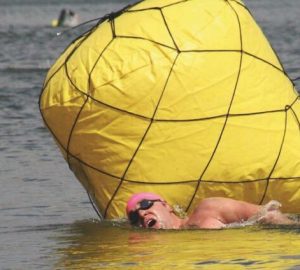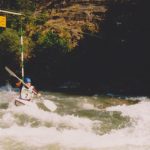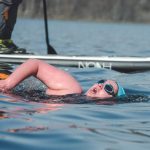Know the drill
When looking to perfect the skill of swimming front crawl we tend to jump at the chance of using a plethora of swimming drills in the hope they will deliver on their incessantly reinforced promises. This can often be without consideration of their benefits or appropriateness in accordance to the stage of our technical ability. On occasions the drill itself may even prompt the onset of a technically poor habit.
With this in mind, I hope to highlight some of the considerations we should make before using some of the main drills and, in turn, increase the awareness of their main purpose and any possible restrictions they may invoke.
Arms only
Swimming with a float (pull buoy) between the legs allows you to focus solely on the arms as well as giving extra lower-body buoyancy to those struggling to lift their legs.
Considerations: If the core isn’t being used and engaged as it should be, it can feel as though the buoyancy of the pull buoy will over-turn you. This in itself can help to create a greater core awareness but be sure it doesn’t create over rotation while doing so. Sometimes swimmers tense and straighten their legs in holding the buoy in place which can cause the legs to lower in the water, defeating the objective of using it in the first place.
Shoulder touch
Incorporating a shoulder touch into each recovery phase is effective in encouraging a high elbow recovery, ensuring an efficient route back to the starting point of the pull. This is performed by touching the shoulder with the hand as it passes by over the water. It isn’t essential the shoulder actually is touched, instead just attempt to get as close as possible.
Considerations: Some swimmers can rush into using this drill without first ensuring their front crawl technique gives them enough reach and roll of the body. Aiming to touch the shoulder without adequate body rotation can create unnecessary stress on the shoulder joint, which can then lead to discomfort or prolonged injury. This drill can also lead to shortening of the underwater phase of the pull. It is easier to achieve high elbow recovery when you don’t complete the pull all the way back to the thigh (as you should), instead exiting the water too early when the hand is by the hips, missing out on a powerful section in the final phase of the pull.
Hand paddles
Effective items to use when looking to emphasise strength of pull in the underwater phase of front crawl. They can also heighten awareness of technique and positioning for the catch phase and remaining pull.
Considerations: Always gradually build up distance when using hand paddles. Due to the increased surface area of your hand while wearing them, you’re able to obtain a greater leverage with more strength applied for each stroke – but overuse without good technique can increase risk of shoulder injuries. It can also lead to the stroke feeling ineffective when you remove the paddles, which could knock your confidence regarding your stroke output.
Catch up
A drill used to help establish and manage stroke timing as well as to emphasise distance per stroke. By having to wait with one arm out stretched in front until the other completes its pull, it forces a strong pull to ensure enough power and momentum is achieved between strokes.
Considerations: Due to the prolonged wait between strokes it may disrupt the flow and rhythm as well as alter the frequency of breathing, both of which can feel uncomfortable and unnatural. As most swimmers will aim to place one hand on top of the other, this drill may also encourage an entry point that goes across the centre line when returning to full stroke. A way of avoiding this is to place hands alongside each other in line with the shoulders when performing the drill.
Hypoxic training
Hypoxic training is swimming while restricting the presence of oxygen. It is often performed by limiting breathing to a lengthened quantity of strokes, eg, breathe every five, seven or nine strokes as opposed to every three. The benefits are seen as being similar to altitude training: encouraging intensity while depriving oxygen, hence increasing the body’s ability to use oxygen. Perhaps more importantly, removing the distraction of breathing (when most stroke errors occur) allows the swimmer to concentrate on good technique. When returning to more frequent breathing, swimmers will be able to put into practice the good technique they have learnt, as well as enjoying the benefits of what can feel like an abundance of available oxygen.
Considerations: Slowly increase the stroke delay with your breathing over time and gradually increase the total amount of lengths swum hypoxic in each session. Trying to restrict breathing for too long too soon can encourage an increase in stroke rate for the sake of rushing the next breath, detracting from distance per stroke and swimming efficiency. Exercising while restricting oxygen can also be dangerous, so be sure to incorporate regular rest intervals when using this.







